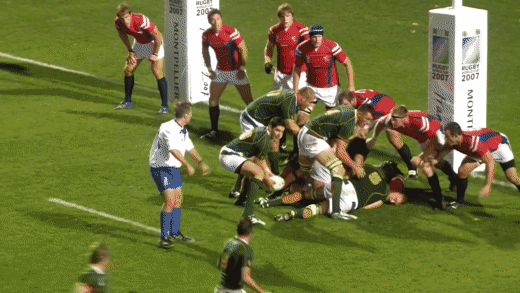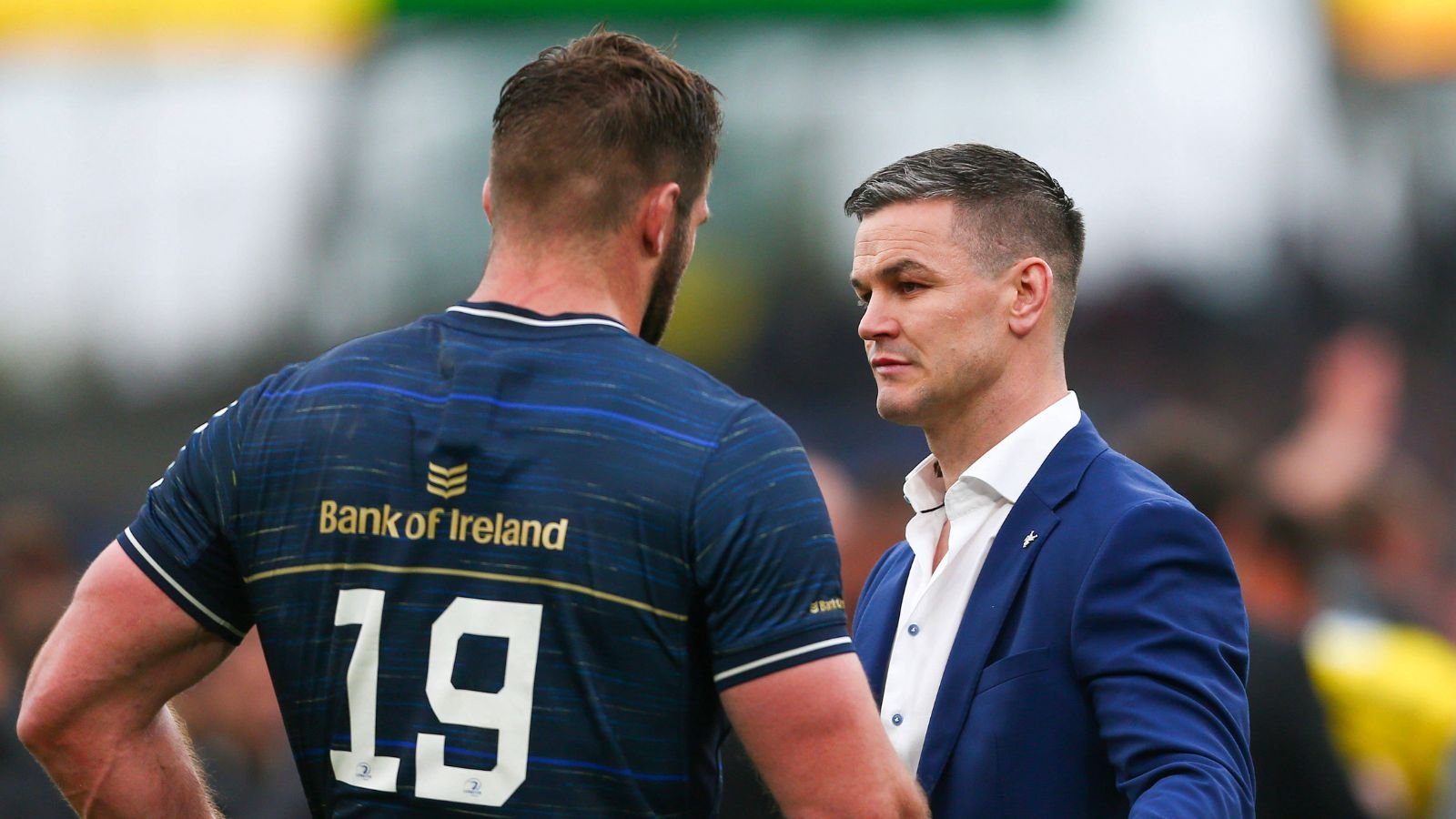Remembering Takudzwa Ngwenya’s try against South Africa in the 2007 World Cup
Takudzwa Ngwenya memorably beats Bryan Habana on the way to a wonder try against South Africa in the 2007 Rugby World Cup
Credit: PATRICK VALASSERIS/AFP/Getty Images
When a World Cup rolls around every four years, it gives rugby fans a glimpse of players they may not be accustomed to seeing on a regular basis.
It applied to Mamuka Gorgodze bursting onto the scene in 2007 for the minnows of Georgia or Ayumu Goromaru starring for Japan in their epic victory over South Africa in the tournament five years ago.
The competition offers not just the biggest players on the planet a chance at glory but also the less recognised ones opportunity to show what they can do when mixing it with the best.
Like Gorgodze, the 2007 World Cup saw another name step forward and announce himself to the watching audience.
That man was Takudzwa Ngwenya and his moment came when he made the “fastest rugby player in the world” look about as quick Wisconsin certifying the 2020 election results.
One sided pool game given shot in the arm
When the draw was made for the 2007 World Cup, nobody gave USA a sniff of getting a win after being placed in a tough pool with England, Tonga, Samoa and eventual winners South Africa.
And so it proved as they lost all four games with a points difference of -81 in the group - with just a solitary bonus point to show for their valiant efforts.
In their final game against South Africa, it was going much the same way as the Springboks were camped on the Super Eagles line at the 39th minute mark with the score 24-3 in their favour.
The pool stage game between England and USA in Lens was a spicy affair
Credit: Getty Images
Ngwenya started his rugby career in his native Zimbabwe before moving to the USA to further his studies.
He joined Dallas Athletic Rugby Club in Texas and represented the US Sevens team before making his senior international debut against England earlier in the tournament.
Little was known about him in the rugby world before the competition but the Super Eagles were aware of his blistering pace - once clocking 10.5 seconds in the 100m dash during training.
Although he was unfamiliar even for 39 minutes of that game during South Africa, he was about to become a star overnight.
Todd Clever intercept and Butch James flattened
Montpellier - 30 September 2007. About 8.39pm local time. South Africa look set to score their bonus point try before half time as they have a ruck in the shadow of the posts.
Jacque Fourie, the outside centre, plays makeshift scrum half and funnels the ball out to Fourie du Preez at first receiver.
He looks to his right and throws a long lefthand pass towards Schalk Burger who is loitering on the wing.
All of a sudden, a blur of hair comes rushing out of the defensive line and Todd Clever - the cult hero known as “Captain America” in rugby circles - comes rushing out the line to intercept.
The burly Californian flanker, who would win USA Rugby Men's Player of the Year in 2008, sets off and quickly realises he most certainly doesn’t have the pace to make the 90 metre dash to the SA red zone.
He does what many forwards do in open field - slow down and look for support while swatting away what defenders they can.
Clever, who has an impressive Youtube showreel of big hits and combative carries, sets his sights on Bath stalwart Butch James who is tracking back.
Instead of making as many metres as he can before he is chopped down, Clever actively looks to bosh James out of the way instead of just pinning his ears back and running.
The South African flyhalf goes far too high in his tackle, which he had a penchant for doing in his career, and simply gets Clevered as he is shoved out the way like a rag doll in a great moment of shithousery.
He eventually shovels the ball onto giant second row Alec Parker who is sprinting in support and you would be forgiven for thinking the flowing move ends there - but how wrong you would be.
Hercus with a lovely long ball to the speedster in waiting
Much like Clever, 6 foot 6 Parker realises he doesn’t have the wheels to threaten the retreating Springboks and shovels onto to the former Sale, Scarlets and Dragons man Mike Hercus.
The crowd in the stadium immediately sensing something special may be on as the American’s main playmaker now has his hands on the ball.
He has three real options:
Kick the ball on for the red jerseys to chase and regather
Take the ball into contact and wait for his teammates but lose that broken field advantage
Throw a Hail Mary pass for his rapid winger who is motoring up the right touchline
Thankfully for everyone involved, he takes the third option throws a lovely left handed pass for Ngwenya to run onto.
However, although the pass is excellent, the distance it has to travel means more South Africa defenders can get back and across to shut off Ngwenya as he catches the pill.
One of those is Bryan Habana, who at the time held the mantle of “the fastest man in rugby” and had raced a cheetah as part of efforts to raise awareness over conservation of the species.
It looks implausible that Ngwenya can get round the man named Bryan Gary after Man United legends Bryan Robson and Gary Bailey.
Surely the USA man has to go through Habana if he wants to get to the tryline or look for support from his teammates? Wrong again dear reader.
The Ngwenya legend is born
Habana and Ngwenya, like two gunslingers, eye each other up as the Zimbabwe born flyer makes his way forwards.
A hitch kick left, a jink to the right and he’s off - using every metre of turf available to him as he tries to squeeze past the Springbok wing.
Much like when Lando Calrissian flies the Millenium Falcon out of the Death Star as the walls explode and close in around him - Ngwenya has a narrow corridor with which to try and get past Habana that is shrinking by the second.
Habana looks as if he is not expecting Ngwenya to try and sprint past him - how dare this unknown even attempt the impossible?
He’s flat footed, slow out the starting block as he scampers after Ngwenya who is now in full flight.
Habana can still get him, dives desperately trying to cut Ngwenya off … but fails as he squeezes by him with Habana’s fingers brushing the electric heels of Ngwenya.
The cherry on top of the cake is Jacque Fourie - the man who started this chaos earlier with his pass to Fourie du Preez - simply accepts that he is not in these guys’ league in terms of pace.
He bows his head and looks on as Ngwenya streaks under the posts and into World Cup immortality.
The behind the posts angle is what makes the try even more special. Balance, poise, footwork and power all perfectly in sync.
It is genuinely poetry in motion and has to be considered one of the great tries of the Rugby World Cup - if not the history of international rugby.
Over the course of 20 seconds, Ngwenya’s life was changed forever as it catapulted him onto the professional stage.
Saracens offered him a month’s trial after the tournament but he turned them down to sign for Biarritz in the Top 14.
He spent nine fruitful years in the Basque country before returning to the San Diego Breakers in Major League Rugby.
Ngwenya returned to Brive in 2016 for another spell before hanging up his boots in 2018 after a spell with San Diego Legion.
South Africa went on to claim an easy 64-15 win, which booked their place in the quarter-finals and then took the William Webb Ellis trophy.
This game was ultimately a footnote in their World Cup triumph, overshadowed by the boy from Zimbabwe with rocket fuel in his boots.
















